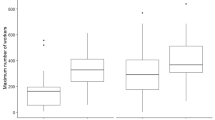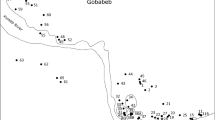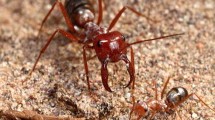Summary
In a population of the monogynous slave-making ant Harpagoxenus sublaevis in S.E. Sweden, the mean proportion of dry weight investment in queens was 0.54. This result differed significantly from 0.75 but not from 0.5, matching the prediction from the genetic relatedness hypothesis of sex ratio applied to slave-makers, given (as confirmed by this study) single mating of queens, population-wide mate competition, and relatively low levels of worker male production. Sex investment appeared unaffected by resource availability. In the same 47 colony population sample, fertile slave-maker workers were found in every queenless colony (ca. 30% of all colonies), and in 58% of queen-right colonies. Fertile workers occurred at a significantly higher frequency in the queenless colonies (19.2%) than in the queenright ones (9.8%), confirming that queenless conditions promote worker fertility. Fertile and sterile workers were similar in size. Electrophoretic allozyme analysis of ants from 49 colonies showed that: 1) queens mated singly; 2) female nestmates were full sisters (their regression coefficient of relatedness (±SE) was 0.735±0.044); 3) inbreeding did not occur; 4) queen and worker siblings were not genetically differentiated. Worker male production in queenright colonies was neither confirmed nor ruled out by the genetic data. However, production data indicated that queenless workers produced between 4.4 and 21.6% of all males. Overall colony productivity was largely determined by slave number, itself positively correlated with the number of slave-maker workers. There was an abrupt switch from all worker to all sexual production as colony size rose, as predicted by life history models. In queenright colonies, fertile slave-makers did not discernibly reduce colony productivity. Such workers occurred in queenright colonies with most slaves, suggesting they exploited energetic surpluses. Worker reproduction in H. sublaevis therefore appears to have greater influence at the level of individual behaviour than at colony or population level.
Similar content being viewed by others
References
Alexander RD, Sherman PW (1977) Local mate competition and parental investment in social insects. Science 196:494–500
Boomsma JJ (1988) Sex investment ratios in ants: has female bias been systematically overestimated? Am Nat (in press)
Boomsma JJ, Isaaks JA (1985) Energy investment and respiration in queens and males of Lasius niger (Hymenoptera: Formicidae). Behav Ecol Sociobiol 18:19–27
Boomsma JJ, Lee GA van der, Have TM van der (1982) On the production ecology of Lasius niger (Hymenoptera: Formicidae) in successive coastal dune valleys. J Anim Ecol 51:975–991
Bourke AFG (1987a) The social biology of the slave-making ant Harpagoxenus sublaevis. PhD thesis, University of Bath
Bourke AFG (1987b) Alternative reproductive strategies in workers of the slave-making ant Harpagoxenus sublaevis. In: Eder J, Rembold H (eds) Chemistry and biology of social insects. Peperny, München, p 259
Bourke AFG (1988a) Dominance orders, worker reproduction, and queen-worker conflict in the slave-making ant Harpagoxenus sublaevis. Behav Ecol Sociobiol (in press)
Bourke AFG (1988b) Worker reproduction in the higher eusocial Hymenoptera. Q Rev Biol (in press)
Buschinger A (1966a) Untersuchungen an Harpagoxenus sublaevis Nyl (Hym Formicidae). I. Freilandbeobachtungen zu Verbreitung und Lebensweise. Insectes Soc 13:5–16
Buschinger A (1966b) Untersuchungen an Harpagoxenus sublaevis Nyl (Hym, Formicidae). II. Haltung und Brutaufzucht. Insectes Soc 13:311–322
Buschinger A (1968) Untersuchungen an Harpagoxenus sublaevis Nyl (Hymenoptera, Formicidae). III. Kopula, Koloniegründung, Raubzüge. Insectes Soc 15:89–104
Buschinger A (1973) The role of daily temperature rhythms in brood development of ants of the tribe Leptothoracini (Hymenoptera; Formicidae). In: Wieser W (ed) Effect of temperature on ectothermic organisms. Springer, Berlin Heidelberg New York, pp 229–232
Buschinger A (1974) Experimente und Beobachtungen zur Gründung und Entwicklung neuer Sozietäten der sklavenhaltenden Ameise Harpagoxenus sublaevis (Nyl). Insectes Soc 21:381–406
Buschinger A (1978) Genetisch bedingte Entstehung geflügelter Weibchen bei der sklavenhaltenden Ameise Harpagoxenus sublaevis (Nyl) (Hym, Form). Insectes Soc 25:163–172
Buschinger A (1983) Sexual behavior and slave raiding of the dulotic ant, Harpagoxenus sublaevis (Nyl) under field conditions (Hym, Formicidae). Insectes Soc 30:235–240
Buschinger A, Alloway TM (1979) Sexual behaviour in the slave-making ant Harpagoxenus canadensis MR Smith, and sexual pheromone experiments with H. canadensis, H. americanus (Emery), and H. sublaevis (Nylander) (Hymenoptera: Formicidae). Z Tierpsychol 49:113–119
Buschinger A, Frenz G, Wunderlich M (1975) Untersuchungen zur Geschlechtstierproduktion der dulotischen Ameise Harpagoxenus sublaevis (Nyl) (Hym, Formicidae). Insectes Soc 22:169–181
Buschinger A, Winter U (1975) Der Polymorphismus der sklavenhaltenden Ameise Harpagoxenus sublaevis (Nyl). Insectes Soc 22:333–362
Buschinger A, Winter U (1978) Echte Arbeiterinnen, fertile Arbeiterinnen und sterile Wirtsweibchen in Völkern der dulotischen Ameise Harpagoxenus sublaevis (Nyl) (Hym, Form). Insectes Soc 25:63–78
Charnov EL (1982) The theory of sex allocation. Princeton University Press, Princeton
Cole BJ (1986) The social behavior of Leptothorax allardycei (Hymenoptera, Formicidae): time budgets and the evolution of worker reproduction. Behav Ecol Sociobiol 18:165–173
Crozier RH (1980) Genetical structure of social insect populations. In: Markl H (ed) Evolution of social behavior: hypotheses and empirical tests. Verlag Chemie, Weinheim, pp 129–145
Crozier RH, Pamilo P, Crozier YC (1984) Relatedness and microgeographic variation in Rhytidoponera mayri, an Australian arid-zone ant. Behav Ecol Sociobiol 15:143–150
Fletcher DJC, Ross KG (1985) Regulation of reproduction in eusocial Hymenoptera. Ann Rev Entomol 30:319–343
Frank SA (1987) Variable sex ratio among colonies of ants. Behav Ecol Sociobiol 20:195–201
Hamilton WD (1964) The genetical evolution of social behaviour I, II. J Theor Biol 7:1–52
Hamilton WD (1967) Extraordinary sex ratios. Science 156:477–488
Hamilton WD (1972) Altruism and related phenomena, mainly in social insects. Ann Rev Ecol Syst 3:193–232
Have TM van der, Boomsma JJ, Menken SBJ (1988) Sex investment ratios and relatedness in the monogynous ant Lasius niger (L). Evolution 42:160–172
Li CC, Horvitz DG (1953) Some methods of estimating the inbreeding coefficient. Am J Human Gen 5:107–117
Menken SBJ (1980) Allozyme polymorphism and the speciation process in small ermine moths (Lepidoptera, Yponomeutidae). Studies in Yponomeuta 2. JH Pasmans BV, S-Gravenhage, The Netherlands
Nonacs P (1986a) Ant reproductive strategies and sex allocation theory. Q Rev Biol 61:1–21
Nonacs P (1986b) Sex-ratio determination within colonies of ants. Evolution 40:199–204
Oster GF, Wilson EO (1978) Caste and ecology in the social insects. Princeton University Press, Princeton
Pamilo P (1982) Genetic population structure in polygynous Formica ants. Heredity 48:95–106
Pamilo P (1983) Genetic differentiation within subdivided populations of Formica ants. Evolution 37:1010–1022
Pamilo P (1984) Genotypic correlation and regression in social groups: multiple alleles, multiple loci and subdivided populations. Genetics 107:307–320
Pamilo P, Rosengren R (1983) Sex ratio strategies in Formica ants. Oikos 40:24–35
Ross KG, Fletcher DJC (1985) Comparative study of genetic and social structure in two forms of the fire ant Solenopsis invicta (Hymenoptera: Formicidae). Behav Ecol Sociobiol 17:349–356
Sokal RR, Rohlf FJ (1969) Biometry. Freeman, San Francisco
Sudd JH, Franks NR (1987) The behavioural ecology of ants. Blackie, Glasgow London
Taylor PD (1981) Sex ratio compensation in ant populations. Evolution 35:1250–1251
Trivers RL, Hare H (1976) Haplodiploidy and the evolution of the social insects. Science 191:249–263
Ward PS (1983a) Genetic relatedness and colony organization in a species complex of ponerine ants. I. Phenotypic and genotypic composition of colonies. Behav Ecol Sociobiol 12:285–299
Ward PS (1983b) Genetic relatedness and colony organization in a species complex of ponerine ants. II. Patterns of sex ratio investment. Behav Ecol Sociobiol 12:301–307
Winter U, Buschinger A (1986) Genetically mediated queen polymorphism and caste determination in the slave-making ant Harpagoxenus sublaevis (Hymenoptera: Formicidae). Entomol Gen 11:125–137
Author information
Authors and Affiliations
Rights and permissions
About this article
Cite this article
Bourke, A.F.G., van der Have, T.M. & Franks, N.R. Sex ratio determination and worker reproduction in the slave-making ant Harpagoxenus sublaevis . Behav Ecol Sociobiol 23, 233–245 (1988). https://doi.org/10.1007/BF00302946
Received:
Accepted:
Issue Date:
DOI: https://doi.org/10.1007/BF00302946




